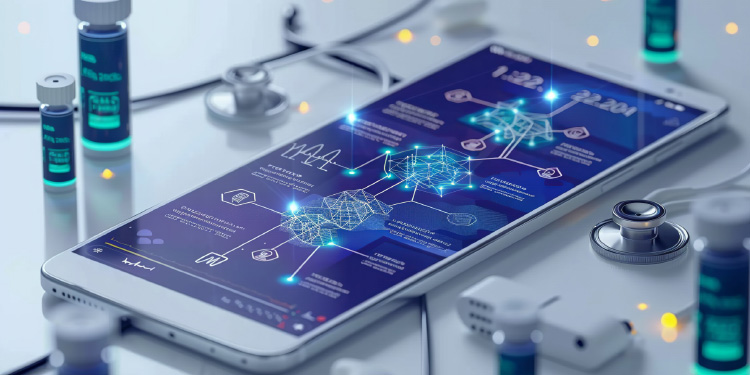In Japan, where people have secure access to quality healthcare, the national healthcare expenses and the elderly population are at record highs. Additionally, the market is expected to grow further, driven by the increasing adoption of digital and AI-based technologies and the promotion of innovation by the government.
Life Science
Government Initiatives

Promoting Innovation Through Data Utilization, Early Drug Approvals, and Support for Pharmaceutical Startups
(1) Utilizing Data and AI in Medical, Nursing Care, and Healthcare
In 2021, the Japanese government's Growth Strategy set forth a policy to promote the introduction of ICT and other technological innovations in the medical, nursing care, and healthcare fields16 , and since then, the government has been promoting the establishment of a data utilization infrastructure and the use of AI in the life sciences sector.
The significant progress can be seen in developing a data utilization infrastructure through the amendment of the Next Generation Medical Infrastructure Act in 2023 (Figure 3). Since 2023, it is expected that the use of medical data by private companies will increase, as "pseudonymized medical data," which has more information than anonymous data, can be used for drug approval and processed medical data, and NDB (National Database of Health Insurance Claims and Specific Health Checkups of Japan) can be analyzed in a consolidated manner. As of September 2023, data on electronic medical records, Comprehensive Assessment System (DPC) surveys, and receipts were provided to private companies and academia in 30 projects.17
Going forward, further improvements will be made to promote an environment for using NDB, including making NDB sample data available, facilitating data access (applying for online remote access), and expanding the functions of the Healthcare Intelligence Cloud (HIC).19
Figure 3: Overview of amendment to the Next Generation Medical Infrastructure Act (2023)
| 1. Establishment of a system for utilization of pseudonymized medical data | From the viewpoint of medical data needs and social benefits, it will be possible to create and provide new "pseudonymized medical data." In the pseudonymized medical data, the medical data (specific test value or disease name) not altered or deleted can be obtained. From the viewpoint of protecting personal information, this information is limited to users authorized by the national government. |
|---|---|
| 2. Consolidation with public databases such as NDB | It is possible to provide anonymously processed information (data in which specific test values and disease names are modified) and a public database such as NDB (Medical treatment, medication, and test values based on information such as receipts and specific medical examinations) in a state that can be connected. The purpose is to expand the possibility of research utilizing medical data. |
| 3. Cooperation with measures to promote the use of medical data | It specifies that medical data providers shall endeavor to cooperate with national policies through providing medical data to authorized providers (as of 2023, there are 113 medical data providers). |
Regarding the use of AI, six priority areas for promoting AI development have been selected, by the government with the aim of solving problems in the health and medical sectors while leveraging Japan's strengths in medical technology (Figure 4).20 Measures to promote AI development, including the use of big data and infrastructure development for cloud environments specifically for AI development, are being implemented in each healthcare area.
In addition, projects related to the utilization of data and AI ("Medical Device and Healthcare Project" and "Genome and Data Infrastructure Project") are being promoted in the government's Healthcare and Medical Strategy, and a budget has been requested for FY 2024 as well. 21
Figure 4: Process chart for promoting AI development in the health, medical, nursing, and welfare sectors
| Areas | Initiatives so far | Initiatives since 2023 |
|---|---|---|
| 1.Genomic medicine |
|
|
| 2.Image diagnosis support |
|
|
| 3.Diagnosis and treatment support |
|
|
| 4.Drug development |
|
|
| 5.Nursing care and dementia |
|
|
| 6.Surgical support |
|
|
(2) Early Approval of Pharmaceuticals and Medical Devices
Since 2022, the government has been working on the implementation of an emergency approval system and the simplification of reviews for expediting approval timelines of Software as a Medical Device (SaMD) which is expected to significantly reduce the sales and distribution time of pharmaceuticals and medical devices.
Since the partial revision of the Pharmaceuticals and Medical Devices Act in FY 2022, an emergency approval system was established to allow approval of all pharmaceuticals, including those not yet distributed overseas, to be approved in Japan if their efficacy is “estimated” (Figure 5).22 Vaccines that have not yet been tested or therapeutic drugs that have not yet undergone large-scale testing are expected to be approved once their safety is confirmed, thereby promoting the development and distribution of pharmaceuticals in Japan.
Figure 5: Overview of special approval/emergency approval
| Normal approval | Special approval | Emergency approval |
|---|---|---|
| Target |
|
All drugs (when there is no appropriate method other than using the drugs to prevent the spread of health hazards in an emergency) |
| Efficacy (Therapeutic Drugs) | Confirmation: Clinical trials (phase III trials) will be conducted. | Presumption: Approval is possible if efficacy is observed in an exploratory clinical trial (late phase II trials). |
| Efficacy (Vaccine) | Confirmation: A national clinical trial will be conducted to confirm that there are no racial or regional differences. | Presumption: Results of large confirmatory clinical trials abroad alone can be approved. |
The number of items granted special approval for emergency was eight until 2022. Among these, seven special approvals were granted for COVID-19 vaccines and antibody drugs, all of which were from foreign companies. As for the emergency approval, one drug related to the COVID-19 virus was approved for production and marketing nine months after the application was made (Figure 6).25
On the other hand, the regulatory reform implementation plan, approved by the Cabinet Office is working towards implementing an early approval for SaMD. It is expected that the time and financial burden of development and marketing will be reduced as measures such as reducing the review period for regulatory approvals and allowing medical data collected in the medical field to be submitted as a substitute for clinical trials are being considered.26 As of the end of March 2023, there were a total of 211 SaMD approvals27, but the number is expected to increase further with the introduction of the early approval.
Figure 6: "Details of drugs with special or emergency approval in 2022
| Classification | Company name (Head office location) | Modality | Examination period |
|---|---|---|---|
| Special | Pfizer (U.S) | Vaccine | 35、69、72、83 |
| Small molecule drugs | 27 | ||
| AstraZeneca (U.K) | Antibody drug | 82 | |
| Moderna (U.S) | Vaccine | 33 | |
| Emergency | Shionogi (Japan) | Small molecule drug | 270 |
(3) Promoting New Drug Discovery
The Japanese government is promoting the development of new innovative drugs and modalities and implementing initiatives such as improving the investment environment, promoting the development of new drugs, and eliminating off-label uses of drugs.
In the Pharmaceutical Industry Vision announced in 2021, a policy for promoting public support, external funding, joint development, and drug discovery research support to improve the investment environment for innovative drug development was established.29 For FY 2024, a budget has been requested to promote the commercialization of pharmaceuticals that meet the needs of medical facilities, and pharmaceutical R&D are being promoted primarily in the fields of next-generation cancer medicine, pediatric, rare diseases, and emerging and re-emerging infectious diseases.30
In addition, to develop efficient and effective new innovative drugs, the Price Maintenance Premium (PMP) to promote the development of new drugs and eliminate off-label uses of drugs, was revised in 2023 to provide a respite from drug price reductions for new drugs without generics. In this system, to consider innovation, additional payment for promotion of new drug development, and elimination of off-label uses of drugs (additional fee for new drug development, etc.) will be temporarily and specially increased to make it comparable to the previous drug prices.31
Figure 7: Top 10 companies (as of March 2023) in terms of the components subject to the additional payment for promotion of new drug development and elimination of off-label uses of drugs
| Ranking | Company name (Head office location) | No. of components | No. of items |
|---|---|---|---|
| 1 | Novartis Pharmaceuticals Corporation (Switzerland) | 25 | 44 |
| 2 | Takeda Pharmaceutical Company Limited (Japan) | 19 | 33 |
| 2 | Janssen Pharmaceuticals (Belgium) | 19 | 28 |
| 2 | Sanofi (France) | 19 | 26 |
| 5 | Pfizer (U.S) | 15 | 24 |
| 6 | MSD (U.S) | 13 | 21 |
| 6 | Chugai Pharmaceutical Co., Ltd. (Japan) | 13 | 21 |
| 8 | DAIICHI SANKYO COMPANY, LIMITED (Japan) | 12 | 32 |
| 9 | Nobelpharma Co., Ltd. (Japan) | 11 | 13 |
| 10 | AstraZeneca (U.K) | 10 | 16 |
This system serves as an incentive for foreign companies and is an important factor in stimulating R&D investment in Japan. The top companies that are subject to this system, including many others, are Novartis Pharmaceuticals Corporation (Switzerland), Sanofi (France), Janssen Pharmaceutical (Belgium), and Pfizer (U.S) (Figure 7).
(4) Supporting Pharmaceutical Startups
For innovative drug discovery, efforts are being made to promote the establishment of an innovation ecosystem through collaboration among pharmaceutical companies, academia, and startups. The Ministry of Economy, Trade and Industry (METI) and the Japan Agency for Medical Research and Development (AMED) are focusing on providing support to pharmaceutical startups because most new drugs are developed by them and they have succeeded in developing vaccines against the COVID-19 virus.33
For example, Strengthening Program for Pharmaceutical Startup Ecosystem, started in 2022, is a system in which AMED grants subsidies to pharmaceutical startups for the development and commercialization of drugs. Under this system, investment by a nationally recognized venture capital (registered VC) is a requirement. Several foreign companies, such as F-Prime Capital Partners (U.S.), Newton Biocapital Partners (Belgium), and Eight Roads Capital Advisors Hong Kong Limited (Hong Kong), have already been selected as registered VCs, and are expected to promote global drug development involving foreign companies.34
In addition, the government is encouraging startups, promoting dialogue between biotechnology startups and investors, and strengthening cooperation among consulting services that support startups in the healthcare sector, including pharmaceuticals and medical devices.35
(5) Supporting the Entry of Foreign Companies in Regions
In addition to national initiatives, proactive efforts are also evident in the regions. Regional initiatives are underway to form a science, technology, and innovation center that leverages the unique characteristics in life sciences, healthcare-related industries, etc., and integrates related industries and human resources36, and the center is working toward attracting foreign companies in the life sciences sector.
In particular, in Open Innovation Kawasaki and the Kobe Biomedical Innovation Cluster, several foreign companies related to pharmaceuticals, biotech, drug discovery, medicine, etc. have entered the market and are actively working to attract foreign companies. The Biologics Center for Research and Training, operating in the Kobe Biomedical Innovation Cluster, has a business alliance with Thermo Fisher Scientific Inc. (U.S) and is working diligently to develop human resource training programs for the development and manufacture of CAR-T cells.37
Besides the science, technology and innovation center, global center are also being formed to strengthen startups in the bio-industry and life sciences.
As part of the bio strategy, formulated to realize the world's most advanced bio-economy society, the global bio community, promoted by the government, aims to build a strategic value chain involving diverse entities from R&D to commercialization. It is expected that the global center will attract human resources, investment from Japan and overseas, and supply products or services in each market area to expand the biotechnology market. In 2022, Greater Tokyo Biocommunity (GTB) and Biocommunity Kansai (BiocK) were selected as global biocommunities in the Kanto and Kansai regions, respectively.38 The fact that private investment in GTB has reached about 3.3 billion USD* (500 billion JPY) (2021-2023)39, and about 100 research institutes, companies, and government ministries/agencies in Japan and overseas have been registered as collaborating institutions of BiocK indicates a strong interest in these facilities.40
In addition, the Cabinet Office has selected sites for the startup ecosystem, and three global sites (Startup Ecosystem Tokyo Consortium, Central Japan Startup Ecosystem Consortium, and Osaka-Kyoto-Kobe Consortium) are engaged in initiatives related to life sciences and healthcare. In these areas, the startup ecosystem is designed to attract outstanding foreign companies.41
-
*
Calculated based on the Bank of Japan exchange rate of 1 USD for 151.38 JPY (as of April 1, 2024)
References
- Cabinet Office. Follow-up on the Growth Strategy (JP), pp. 93-97.
- Office of Healthcare Policy, Cabinet Office. Amendment to the Next Generation Medical Infrastructure Act (JP), pp. 2, 4-8, 10.
- See Note 16, pp. 93-97.
- See Note 17, pp. 2, 4-8, 10.
- MHLW. Follow-up of the process chart for the promotion of AI development based on an overview chart (JP), p. 2.
- Cabinet Office. Points of R&D Budget in Medical Sector in FY 2024 (JP), p. 1.
- MHLW. Leaflet: Emergency Approval System Enacted (JP).
- MHLW. Follow-up of the process chart for the promotion of AI development based on an overview chart (JP), p. 2.
- MHLW. Leaflet: Emergency Approval System Enacted (JP).
- Office of Pharmaceutical Industry Research (OPIR). New Drugs Approved in Japan and Their Review Periods: A Survey of Approval Results and Chronological Trends in 2022 (JP).
- Cabinet Office. Regulatory Reform Implementation Plan (JP), pp. 78-80.
- PMDA. PMDA's Initiatives for Medical Devices (JP), p. 10.
- OPIR. New Drugs Approved in Japan and Their Review Periods: A Survey of Approval Results and Chronological Trends in 2022 (JP).
- MHLW. Pharmaceutical Industry Vision 2021: Towards a Pharmaceutical Industry Policy to Achieve Both Medical and Economic Development and a Safe and Secure Life (JP), pp. 1-2.
- Cabinet Office. Points of R&D Budget in Medical Sector in FY 2024 (JP). Overview of Integrated Projects in FY 2029 Budget (JP), p. 2-3.
- MHLW. Outline of the Revision in the Drug Pricing System in FY 2023 (JP), pp. 1-3.
- MHLW, Companies with products subject to the additional payment for promotion of new drug development and elimination of off-label uses of drugs (JP), p. 1.
- MHLW. Foothold Initiatives for Innovative Drug Discovery (JP).
- Japan Agency for Medical Research and Development (AMED). Strengthening Program for Pharmaceutical Startup Ecosystem.
- METI. "Action Plan 2021" for the Creation of New Health and Medical Industries (JP), pp. 13-15.
- MEXT. "Large-Scale Science, Technology, and Innovation Centers in Regional Areas" (JP), 2023 White Paper on Science, Technology, and Innovation, Part I, Chapter 2.
- Biological Center for Research and Training (BCRET). Press Release: Business Alliance with Thermo Fisher Scientific Inc. (JP).
- Cabinet Office. Decision on Selection Results for the Formation of a Global Bio-community (JP).
- Greater Tokyo Biocommunity. GTB Resource.
- BiocK. "Partner Organizations," About us.
- Council for Science, Technology and Innovation, Cabinet Office. Startup Ecosystem Hub Cities (JP), p. 2.
-
Overview
The Life Sciences Sector of Japan Is Expected to Expand Due to the Elderly Population, the Promotion of Innovation, and the Introduction of Digital Technologies

-
Attractive Markets
The Five Attractive Markets in the Life Sciences Industry
-
(1)
Pharmaceuticals: Foreign companies active in the steadily growing market
-
(2)
Medical Devices: Expanding demand in the market estimated as the world’s fourth largest
-
(3)
Regenerative Medicine: Practical application promoted through institutional development
-
(4)
Digital Health: Advancing collaboration across a wide range of areas
-
(5)
Nursing Care: Continuous growth expected with an aging population

-
Life Science Report

You can download the whole report on the webpage free of charge. Please simply fill out the form below to get information on promising industries in the Japanese market. Download now and use the information for your success in business.
-
- Business Expanding
- Biotechnology & Life Science
- USA
Cellares, an integrated development and manufacturing organization specializing in clinical and industrial-scale cell therapy manufacturing, plans to establish a smart factory in Kashiwa, Japan
-
- Business Expanding
- Biotechnology & Life Science
- Korea
AIRS Medical, a Korean startup who develops an AI-based MRI image reconstruction software that reduces scanning time and improves image quality at the same time, enters the Japanese market
-
- Business Expanding
- Biotechnology & Life Science
- Korea
Doctornow, a company that develops and operates a platform for online doctor consultations, establishes an office in Tokyo
Contact Us
Investing in and collaborating with Japan
We will do our very best to support your business expansion into and within Japan as well as business collaboration with Japanese companies. Please feel free to contact us via the form below for any inquiries.
Inquiry FormJETRO Worldwide
Our network covers over 50 countries worldwide. You can contact us at one of our local offices near you for consultation.
Worldwide Offices



























